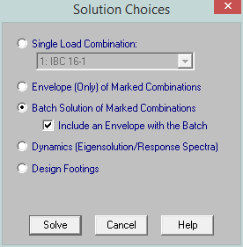
Note:
Four solution options are presented
when you click Solve on the menu. Some of the options require
other solution types to be performed. See Results
for information on solution results. For additional information
on Dynamic
Analysis and Response
Spectra Analysis results refer directly to those sections.

Static solutions are based on load combinations
and may be performed on any defined load combinations. When
a static solution has been performed and the results are available the![]() to
to ![]()
The solution is based on the widely accepted linear elastic stiffness method for solution of the model. The stiffness of each element of the structure is calculated independently. These element stiffnesses are then combined to produce the model's overall (global) stiffness matrix. This global matrix is then solved versus the applied loads to calculate joint deflections. These joint deflections are then used to calculate the individual element stresses. The primary reference for the procedures used is Finite Element Procedures, by K. J. Bathe (Prentice-Hall, 1996).
This solution method is also sometimes referred to as an Active Column solution method. In finite element analysis, the nonzero terms of the stiffness matrix are always clustered around the main diagonal of the stiffness matrix. Therefore, the Skyline or Active Column solutions take advantage of this by condensing the stiffness matrix to exclude any zero stiffness terms that exist beyond the last non-zero term in that column of the matrix.
Since the majority of terms in a stiffness matrix are zero stiffness terms, this method greatly reduces the storage requirements needed to store the full stiffness matrix. However, for large models (+10,000 joints) , the memory requirements even for a skyline solution can be problematic.
This solution method has been used successfully in RISA for more than 20 years, and has proven its accuracy continuously during that time.
Choose this option to solve one load combination by itself.
Static solutions may also be performed on multiple combinations and the results enveloped to show only the minimum and maximum results. Each of the results spreadsheets will contain minimum and maximum values for each result and also the corresponding load combination. The member detail report and deflected shape plots are not available for envelope solutions. See Load Combinations to learn how to mark combinations for an envelope solution.
Static solutions may be performed on multiple combinations and the results retained for each solution. When performing a batch solution, you have the option to also include a set of envelope results. This is useful when an envelope result is desired to quickly determine a controlling load combination, but when the investigation of that load combination required the greater details given with batch solution results. When using the Batch + Envelope Solution, to view the envelope results, click on a spreadsheet in the Results toolbar. To view the batch results, click on that same spreadsheet in the Results toolbar a second time. Both the envelope and batch solution spreadsheets should now be available simultaneously.
You
may group the results by item or by load combination by choosing from
the
In this section, the term "Dynamic Solutions" refers to solving of the dynamic properties of a structure. This involves assembling the mass matrix, solving for the eigen values (natural periods / frequencies), as well as determining the mode shapes of vibration associated with each period / frequency. Dynamic analysis requires a load combination, but this combination is merely used to determine the mass of the model. See Dynamic (Modal) Analysis for much more information.
When a dynamic
solution has been performed and the results are available the
![]() to
to ![]()
The Accelerated Solver is actually three solvers in one: A Direct Jacobian, an Accelerated Sub-Space solver, and a Lanczos Solver. Each of these solvers will have a certain range of models for which it is most efficient. Therefore, RISA will automatically detect which should be most efficient for the given model and use that solver for the eigen-solution. This solver is much more efficient than the standard solver and will fine frequencies and mode shapes in a fraction of the time the standard solver. Therefore, it is the default solution option.
This solver uses sub-space iteration to solve for the Eigen values. This solver has been used for years and the accuracy of the results is very well established. It has been included mostly for comparative / verification purposes.
This solver uses Load Dependent Ritz (LDR) vectors to bias the dynamic solution. This means that the solution does not necessarily represent the true mode shapes or natural frequencies of the structure. As such, this solution should not be used in cases where the natural frequencies and modes shapes are the main goal.
Ritz vectors are derived by using a static displacement vector as the basis of the derived vector, only allowing for the solution of modes / vectors that will be excited by the initial loading or which will contribute to the total response. In RISA, the initial static displacement vectors are based on the load combination used for the definition of dynamic mass. The mass defined in this load combination is converted into a static load in each direction for which a Response Spectra solution is requested. The solution of which forms the basis for the initial Ritz Vectors.
Note:
Note: